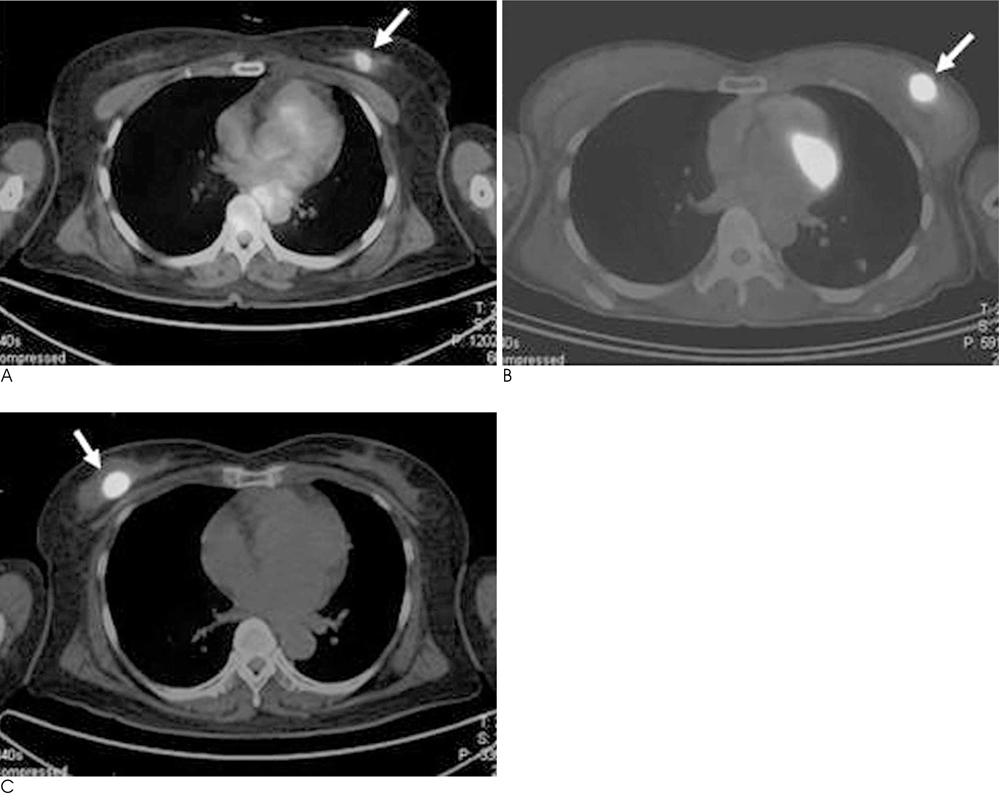J Korean Soc Radiol.
2010 Sep;63(3):287-292. 10.3348/jksr.2010.63.3.287.
Factors Affecting 18F-Fluorodeoxyglucose (FDG) Uptake in Breast Cancer
- Affiliations
-
- 1Department of Radiology, Soonchunhyang University Bucheon Hospital, Korea. grace@schbc.ac.kr
- 2Department of Nuclear Medicine, Soonchunhyang University Bucheon Hospital, Korea.
- 3Department of Radiology, Konkuk University Hospital, Korea.
- KMID: 2097907
- DOI: http://doi.org/10.3348/jksr.2010.63.3.287
Abstract
-
PURPOSE: To evaluate factors affecting 18F-Fluorodeoxyglucose (FDG) uptake in breast cancer.
MATERIALS AND METHODS
For 3 years from 2006, 180 patients (mean age 48-years-old) with 187 breast cancers underwent positron emission tomography-computed tomography (PET/CT; biograph2, Siemens) at our institute and were enrolled in this study. We evaluated whether there was a correlation between the peak standardized uptake value (pSUV) of PET/CT and the histologic type of the breast cancers (n=187), grade of the invasive ductal cancers (n=142), and tumor size (n=153).
RESULTS
The different histologic types of breast cancers include IDCs (n=156), in situ ductal carcinoma (n=10), papillary cancer (n=6), mucinous cancer (n=6), invasive lobular cancer (n=4), medullary cancer (n=3), metaplastic cancer (n=1), and neuroendocrine cancer (n=1). pSUV showed significant differences according to histologic type (p<0.005). For the available cases (n=142), IDCs were classified as grade 1 (n=25), grade 2 (n=66), and grade 3 (n=51) and correlated with the histologic grade of IDCs (rho=0.41, p<0.001). pSUV was correlated with tumor size regardless of histologic type (rho=0.525, p<0.001). In low grade IDCs, pSUV was correlated with tumor size (rho=0.48-0.86, p<0.001), but not in high grade IDCs (p>0.001).
CONCLUSION
Regardless of histologic type, the larger the breast cancer, the higher the pSUV; in addition, the higher the grade of IDCs, the higher the pSUV. For the low grade IDCs, pSUV is correlated with tumor size; however, this is not the case in high grade IDCs.
MeSH Terms
Figure
Reference
-
1. Oh GG, Moon WG, Son EJ, Kim MH, Jung SY, Ko GR, et al. 유방질환의 영상검사. In : Jung SY, Han BG, editors. Korean Society of Breast Imaging. Breast Diagnostic Imaging. Ilchokak;2008. p. 121.2. Rosen EL, Eubank WB, Mankoff DA. FDG PET, PET/CT, and breast cancer imaging. Radiographics. 2007; 27:S215–S229.3. Lim HS, Yoon W, Chung TW, Kim JK, Park JG, Kang HK, et al. FDG PET/CT for the detection and evaluation of breast diseases: usefulness and limitations. Radiographics. 2007; 27:S197–S213.4. Noh DY, Yun IJ, Kim JS, Kang HS, Lee DS, Chung JK, et al. Diagnostic value of positron emission tomography for detecting breast cancer. World J Surg. 1998; 22:223–227.5. Wahl RL, Cody RL, Hutchins GD, Mudgett EE. Primary and metastatic breast carcinoma: initial clinical evaluation with PET with the radiolabeled glucose analogue 2-[F-18]-fluoro-2-deoxy-D-glucose. Radiology. 1991; 179:765–770.6. Crowe JP, Adler LP, Shenk RR, Sunshine J. Positron emission tomography and breast masses comparison with clinical, mammographic, and pathological findings. Ann Surg Oncol. 1994; 1:132–140.7. Moon DH, Maddahi J, Silverman DH, Glaspy JA, Phelps ME, Hoh CK. Accuracy of whole-body fluorine-18-FDG PET for the detection of recurrent or metastatic breast carcinoma. J Nucl Med. 1998; 39:431–435.8. Palmedo H, Bender H, Grunwald F, Mallmann P, Zamora P, Krebs D, et al. Comparison of fluorine-18 fluorodeoxyglucose positron emission tomography and technetium-99 m methoxyisobuty lisonitrile scintimammography in the detection of breast tumours. Eur J Nucl Med. 1997; 24:1138–1145.9. Kumar R, Chauhan A, Zhuang H, Chandra P, Schnall M, Alavi A. Clinicopathologic factors associated with false negative FDG-PET in primary breast cancer. Breast Cancer Res Treat. 2006; 98:267–274.10. Avril N, Rose CA, Schelling M, Dose J, Kuhn W, Bense S, et al. Breast imaging with positron emission tomography and fluorine-18 fluorodeoxyglucose: use and limitations. J Clin Oncol. 2000; 18:3495–3502.11. Samson DJ, Flamm CR, Pisano ED, Aronson N. Should FDG PET be used to decide whether a patient with an abnormal mammogram or breast finding at physical examination should undergo biopsy? Acad Radiol. 2002; 9:773–783.12. Adler LP, Crowe JP, al-Kaisi NK, Sunshine JL. evaluation of breast masses and axillary lymph nodes with [F-18] 2-deoxy-2- fluoro-D-glucose PET. Radiology. 1993; 187:743–750.13. Schirrmeister H, Kuhn T, Guhlmann A, Santjohanser C, Horster T, Nussel K, et al. Fluorine-182-deoxy-2-fluoro-D-glucose PET in the preoperative staging of breast cancer: comparison with the standard staging procedures. Eur J Nucl Med. 2001; 28:351–358.14. Kumar R, Alavi A. Fluorodeoxyglucose-PET in the management of breast cancer. Radiol Clin North Am. 2004; 42:1113–1122.15. Eubank WB, Mankoff DA. Evolving role of positron emission tomography in breast cancer imaging. Semin Nucl Med. 2005; 35:84–99.16. Crippa F, Seregni E, Agresti R, Chiesa C, Pascali C, Bogni A, et al. Association between [18F]fluorodeoxyglucose uptake and postoperative histopathology, hormone receptor status, thymidine labelling index and p53 in primary breast cancer: a preliminary observation. Eur J Nucl Med. 1998; 25:1429–1434.17. Avril N, Menzel M, Dose J, Schelling M, Weber W, Janicke F, et al. Glucose metabolism of breast cancer assessed by 18F-FDG PET: histologic and immunohistochemical tissue analysis. J Nucl Med. 2001; 42:9–16.18. Buck A, Schirrmeister H, Kuhn T, Shen C, Kalker T, Kotzerke J, et al. FDG uptake in breast cancer: correlation with biological and clinical prognostic parameters. Eur J Nucl Med Mol Imaging. 2002; 29:1317–1323.19. Buck AK, Schirrmeister H, Mattfeldt T, Reske SN. Biological characterisation of breast cancer by means of PET. Eur J Nucl Med Mol Imaging. 2004; 31:Suppl 1. S80–S87.20. Yoo JH, Choi HY, Ahn SH. Misdignosed Breast Cancer on Mammography: Retrospectie Analysis in 17 Cases. J Korean Radiol Soc. 1995; 32:501–506.21. Kim YC, Park HJ, Han H, Lim DM, Chung HS, Kim JE, Kim YC. Analysis of Mammographic Findings of Breast Cancer. J Korean Radiol Soc. 1995; 32:337–342.
- Full Text Links
- Actions
-
Cited
- CITED
-
- Close
- Share
- Similar articles
-
- 18F-FDG PET/CT Findings in a Breast Cancer Patient with Concomitant Tuberculous Axillary Lymphadenitis
- Diffuse Intense 18F-FDG Uptake at PET in Unilateral Breast Related to Breastfeeding Practice
- Perirenal 18F-FDG Uptake in a Patient with a Pheochromocytoma
- 18F-Fluorodeoxyglucose Positron Emission Tomography/CT Scan Findings for Ductal Carcinomas of Breast: Association of Standardized Uptake Value and Histological Findings
- Clinical Significance of Focal Breast Lesions Incidentally Identified by 18F-FDG PET/CT




